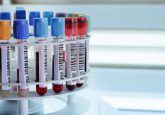Nanoscience for faster immunological testing: combining new techniques with old

New research published in the journal Small has described a new technique that could be used in the future for faster diagnosis of a wide range of infectious diseases, such as HIV, syphilis and Lyme disease. The technique, which uses magnetic nanoparticles, combines both old and new scientific principles to create a faster method of immunological testing.
In this study, researchers at the University of Central Florida (FL, USA) applied an, until now, untested principle, known as Faraday rotation, to a well-known diagnostic test. The researchers coated nanoparticles with antibodies to bovine serum albumin, which is a basis to a wide range of diagnostic tests. Subsequently, when emerged in test solution, the antibodies coating the nanoparticles preferentially bind to the bovine serum albumin. By adapting this commonly used diagnostic test, the researchers were able to quantify the number of proteins present in the sample.
The team adapted the principle of Faraday rotation by utilizing nanoparticles with an iron core. A magnetic field was then applied to the sample, which caused the particles in the sample to align in a specific formation.
When the antibodies that coat the nanoparticles subsequently bound to the proteins in the sample, the rotation of these particles slowed down due to the magnetic field, allowing easier quantification using laser optics.
This is the first time this principle has been tested for this purpose. “It’s an old theory, but no one has actually applied this aspect of it,” explained Shawn Putnam, a researcher and assistant professor at the University of Central Florida’s College of Engineering & Computer Science.
If commercialised, this novel technique could be used for the diagnosis of a wide range of infectious diseases by substituting the bovine serum albumin and antibodies used in this study for other targets.
This technique for immunological testing has been demonstrated to take as little as 15 minutes, which is favourable when compared with current immunological tests such as ELISA, which takes several hours.
This technique may be of significant use for a wide range of medical testing purposes. Putnam commented on the possibilities of these findings: “I see no reason why a variation of this technique couldn’t be in every hospital throughout the world.”
Sources: Murdock RJ, Putnam SA, Das S, Gupta A, Chase ED, Seal S. High-throughput, protein-targeted biomolecular detection using frequency-domain Faraday rotation spectroscopy. Small. doi:10.1002/smll.201602862 (2017) (Epub ahead of print); http://today.ucf.edu/nanoscience-medical-test/






